What is the Mirror Test?
The mirror test, also known as the mark test, is a widely used behavioral technique. It’s focus is to determine an animal’s ability to recognize itself in a mirror. American psychologist Gordon Gallup Jr. first introduced the test in 1970, and it has since been used widely on various species of animals.
The method involves placing a mark or colored spot on the animal’s body. The animal can’t see the mark with a mirror. Then, researchers observe whether the animal attempts to remove or investigate the mark after they see their reflection. If they do so consistently, it suggests they are aware that their body is being reflected back at them.
While not all animals have passed this test with flying colors, some have shown remarkable self-awareness abilities. Despite widespread use and popularity among scientists studying animal cognition and behaviorism, some critics question the technique’s validity for measuring self-awareness in non-human creatures. Nonetheless, many experts consider it useful for understanding certain aspects of an animal’s social intelligence and behavior patterns.
Which Animals Passed the Mirror Test?
So far, only a limited number of species have passed this cognitive assessment. These include mammals, fish and primates. So far, chimpanzees, orangutans, dolphins, killer whales, elephants, European magpies, manta rays and horses have already passed the test. However, it is important to note that just because an animal has not yet passed the mirror test does not necessarily mean they lack self-awareness altogether. Therefore, we still need further research to fully understand animal consciousness.
Bottlenose Dolphin

Bottlenose dolphins are among some of the smartest animals, and it’s no surprise they can pass the mirror test.
©iStock.com/Lefteris_
The bottlenose dolphin (Tursiops truncates) is a highly intelligent and social marine mammal that can be found in oceans all over the world. In 1994, researchers conducted a mirror test on captive bottlenose dolphins to determine their level of self-awareness. During this study, several bottlenose dolphins were able to recognize themselves in mirrors and pass the mirror test. This suggests these animals have some self-awareness and cognitive abilities similar to those seen in other highly intelligent species.
An additional study in 2018 finds bottlenose dolphins can recognize themselves earlier than other animals that passed the mirror test. This finding has important implications for our understanding of animal cognition, consciousness, and relationship with these fascinating creatures. Further research is needed to fully understand the extent of dolphin intelligence and what this means for their conservation and welfare in captivity.
Killer Whale

Killer whales, like bottlenose dolphins, have sharp cognitive abilities.
©qingqing/Shutterstock.com
The killer whale, also known as Orcinus orca, is a highly intelligent and social marine mammal in the dolphin family. They are apex predators of the ocean and are found in all major oceans around the world.
Although some species failed this test, killer whales demonstrate remarkable cognitive abilities when tested with mirrors. In fact, several studies conducted on captive killer whales suggest they possess enough self-awareness to recognize themselves in mirrors.
One study involved Tilikum -a 12-foot long male captured from Icelandic waters- who was repeatedly observed sticking his tongue out at his reflection after being marked with non-toxic paint during testing sessions at SeaWorld Orlando. Other researchers reported similar results with other captive killer whales showing signs of recognizing themselves in mirrors by exhibiting behaviors such as blowing bubbles while facing their reflections or using their mouths to explore marks placed on their bodies.
In conclusion, despite being one of nature’s most formidable creatures capable of hunting prey much larger than themselves, these majestic animals seem capable of introspection too!
False Killer Whale

False killer whales are one of the mirror test animals that show recognition.
©Hawkeagle20/Shutterstock.com
A false killer whale (Pseudorca crassidens) is a large oceanic dolphin species found in temperate and tropical waters all around the world. They are known for their long, slender bodies and black or dark gray coloration.
In 2010, researchers conducted a study on two captive false killer whales at Sea Life Park Hawaii to see if they would pass the mirror test. The whales were each marked with non-toxic black ink on areas of their skin that they could not normally see. When presented with mirrors in their tanks, both whales spent more time investigating these previously unknown marks than unmarked areas of their bodies – indicating they recognized themselves.
This was one of several studies done on cetaceans (whales and dolphins) attempting to assess self-awareness via reflective surfaces. While not every species has passed this particular cognitive examination yet – including other members of the Pseudorca genus like Risso’s Dolphin – findings such as these continue to deepen our understanding of what makes different animals unique.
Bonobo
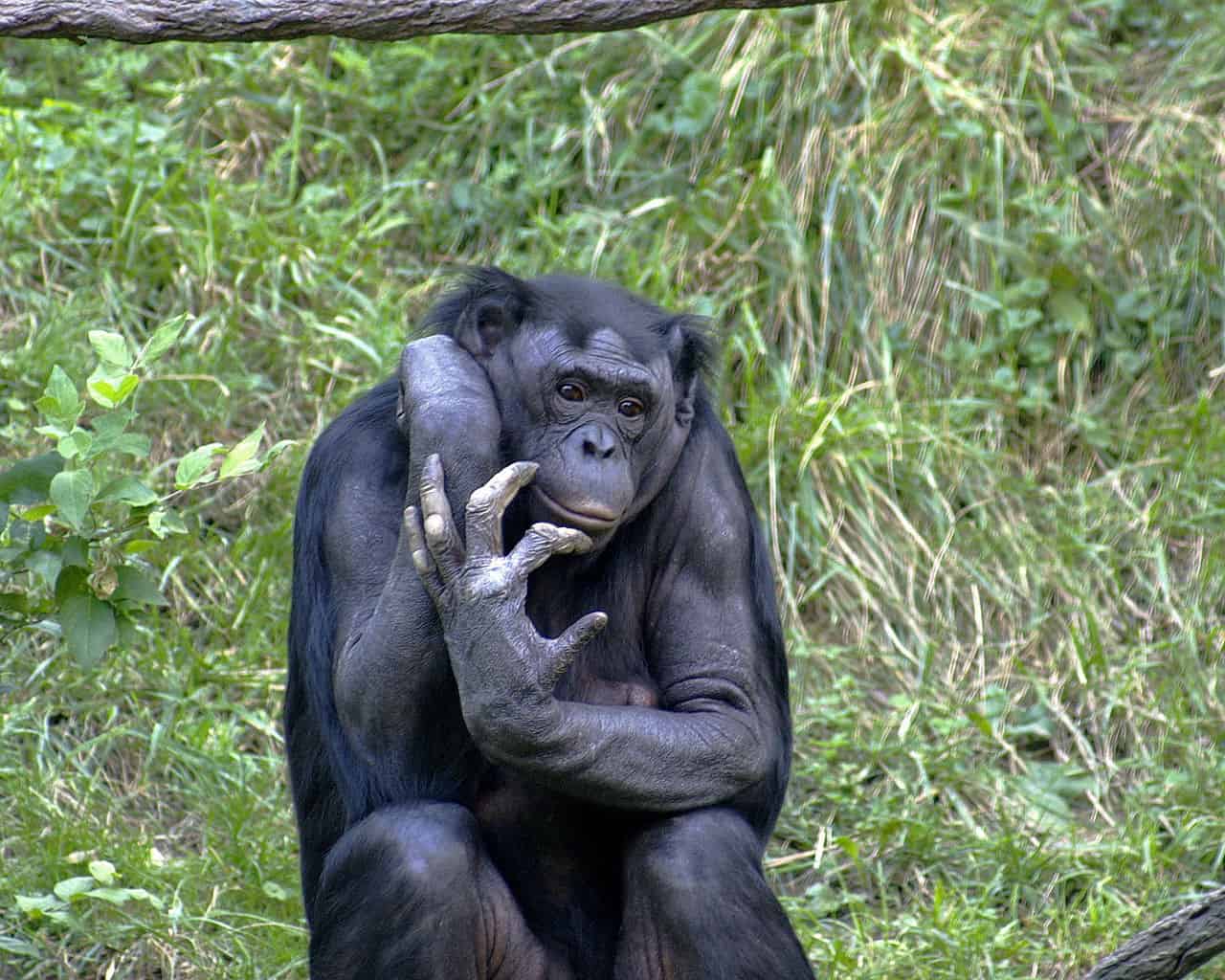
Bonobos can pass the mirror test and have similar cognitive abilities to the bottlenose dolphin
©Kabir Bakie / CC BY-SA 2.5, from Wikimedia Commons, the free media repository – License
The bonobo, also known as the pygmy chimpanzee, is a species of great ape that inhabits the forests of the Democratic Republic of Congo in Central Africa. They are closely related to chimpanzees and share many physical and behavioral traits with them.
In 1995, researchers at Emory University conducted a series of mirror tests on captive bonobos using red lip paint as the marking substance. The results showed that most adult bonobos passed the test by exhibiting behaviors indicating self-awareness. Their behaviors included looking at themselves while examining their marks or making faces at themselves in response to their reflection.
These findings suggest that bonobos possess cognitive abilities similar to those observed in intelligent animals like dolphins and elephants, who also passed the mirror test. The research highlights how much there still is to learn about these fascinating creatures. It also marks how important we continue studying them both for our understanding of evolution and because many species, like Bonobos, face habitat destruction threats due to human activities.
Bornean Orangutan
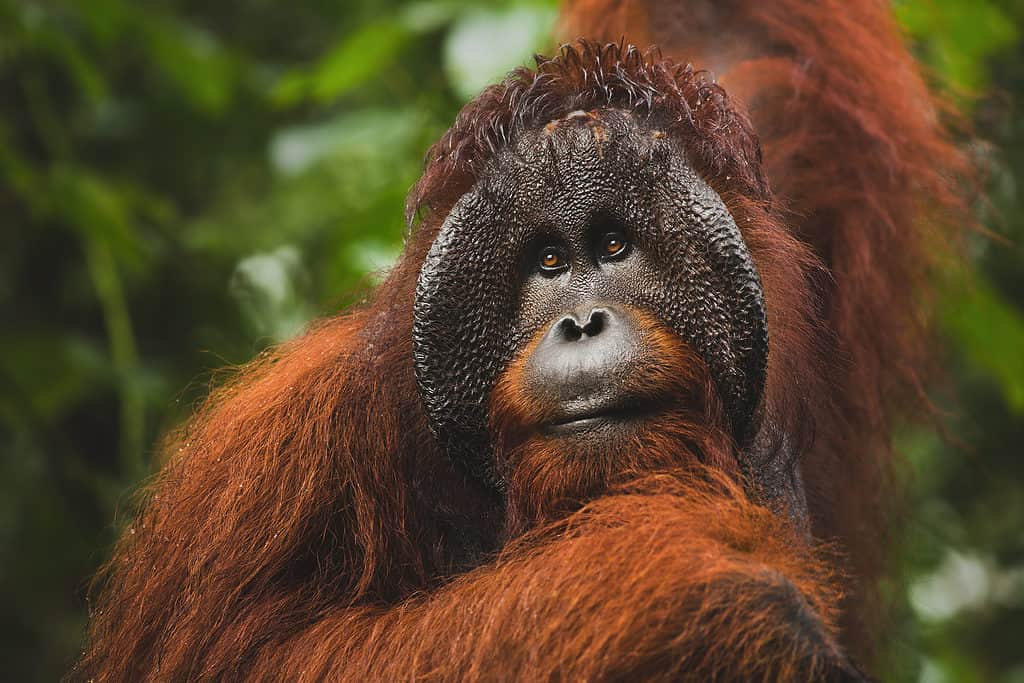
Captive Bornean orangutans are capable of recognizing themselves and passing the mirror test.
©Marketa Myskova/Shutterstock.com
A Bornean orangutan is a species of great ape that is native to the island of Borneo in Southeast Asia. These primates are known for their distinctive reddish-brown fur and long arms, which they use to swing through trees with ease.
A study conducted on captive Bornean orangutans found that these intelligent apes could recognize themselves in mirrors. When shown a reflective surface, the orangutans displayed behaviors such as touching their own faces or examining parts of their bodies not normally visible without a mirror. This suggests that they had some degree of understanding about what was being reflected back at them.
Many animals have failed the mirror test altogether or shown only limited success in completing it – indicating that while self-awareness may be present across certain species lines, it does not necessarily exist universally among all living things.
Chimpanzee
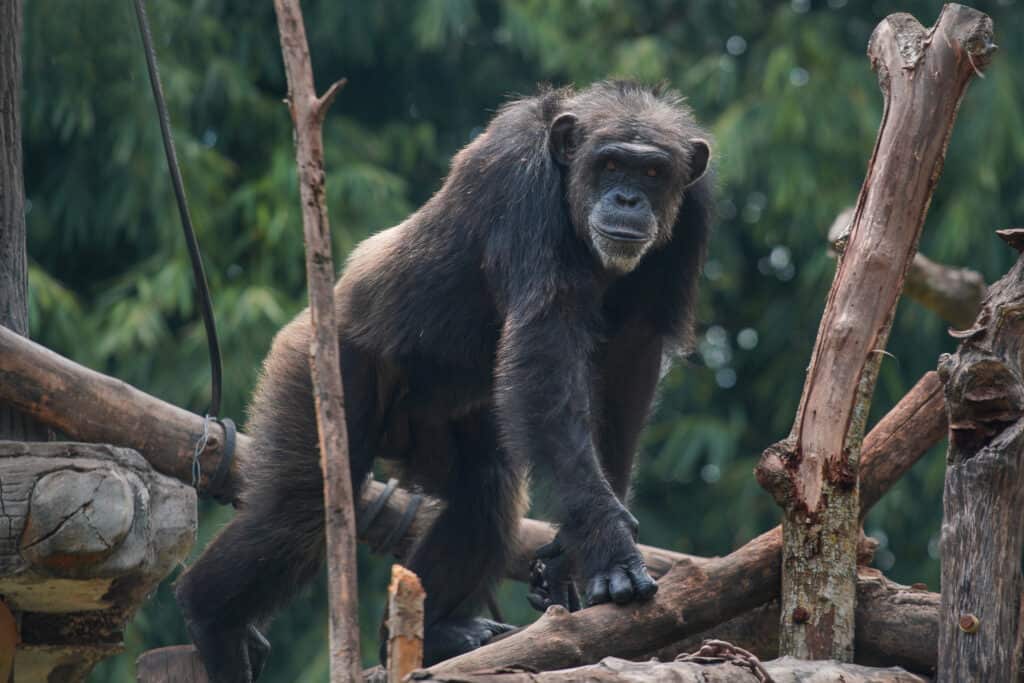
Some, not all, chimpanzees can pass the mirror test.
©Dhimas Satriaa/Shutterstock.com
The chimpanzee, also known as Pan troglodytes, is a species of great ape that is closely related to humans. Chimps are highly intelligent and have been observed exhibiting complex behaviors such as tool use and communication through sign language.
In the case of chimpanzees, researcher Gordon Gallup conducted the first known mirror test with them in 1970. The parameters of the test involved placing red dye on specific parts of each chimpanzee’s face that could only be seen in their reflection. If they recognized themselves, they would attempt to touch or manipulate the marked area on their own face.
The outcome was that some, but not all, chimpanzees passed the test. This suggests that while they possess some self-awareness, it may vary among individuals and possibly even within different contexts.
You should note there is criticism of this particular method for measuring self-awareness, as it may not account for other forms of awareness or consciousness in animals beyond visual recognition through mirrors. Nonetheless, it remains one method researchers have explored cognitive abilities across species, including primates like chimpanzees.
Western Gorilla
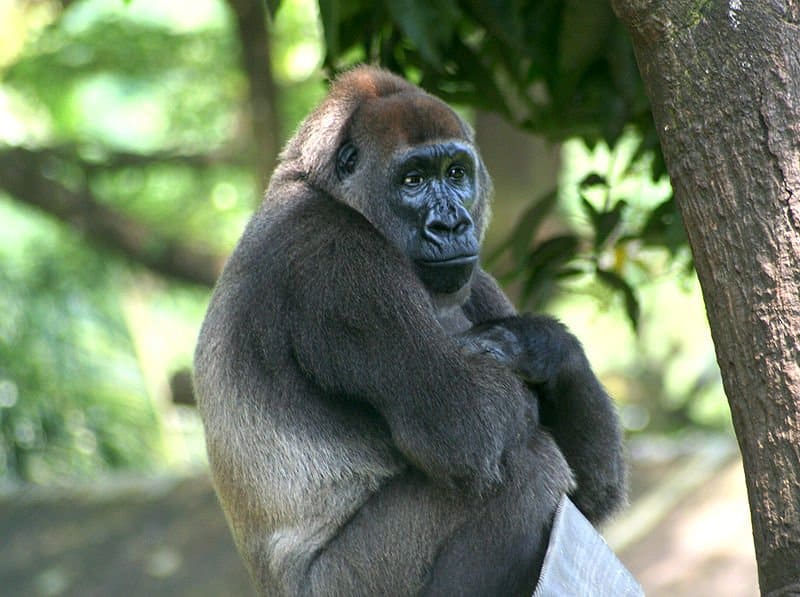
Some western gorillas could recognize themselves in mirrors, but further testing is needed.
The western gorilla (Gorilla gorilla) is one of two subspecies of the western gorilla species. They are native to Central Africa‘s forests and are considered endangered due to habitat loss, poaching, and disease.
As for the mirror test, four different versions were conducted on gorillas: the mark test, the video self-recognition test, the social response reversal experiment, and the infrared-sensitive eye-tracking experiment. The results showed that some individual gorillas could recognize themselves in mirrors, while others did not appear to understand what they were seeing.
While this may seem trivial, passing the mirror test is an important indicator of animal self-awareness and cognitive ability. It shows that they have a sense of self-identity separate from their environment or other individuals within their species. Overall, we need more research on how various animals perceive mirrors and what it means for their cognitive abilities.
Asian Elephant
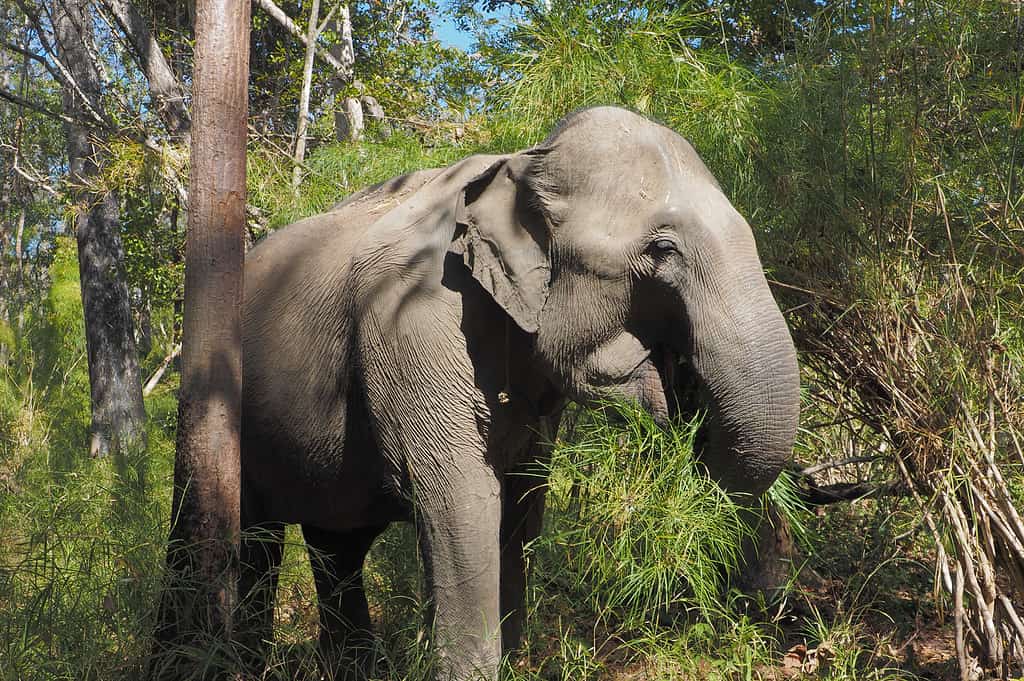
Asian elephants were slow to pass the mirror test, but one female named Happy recognized herself.
©DorSteffen/Shutterstock.com
The Asian elephant, scientifically known as Elephas Maximus, is an elephant species primarily found in Southeast Asia’s forests and grasslands. They are slightly smaller than their African counterparts and have distinct features like small ears and rounded backs.
In 2006, an experiment was conducted on Asian elephants to determine if they possess self-awareness – a cognitive ability considered unique to humans. In this particular study, researchers placed a large mirror in front of three captive Asian elephants for several days.
At first, the animals showed signs of aggression towards their reflections by trumpeting and flapping their ears. However, after several attempts at touching their own bodies while looking at themselves in the mirror, one female elephant named Happy eventually passed the test and recognized her reflection.
This groundbreaking discovery suggests that some animals have complex cognitive abilities beyond what we previously believed them capable of possessing. The results from this study could potentially change our understanding of how other species perceive themselves and interact with their environment.
Eurasian Magpie
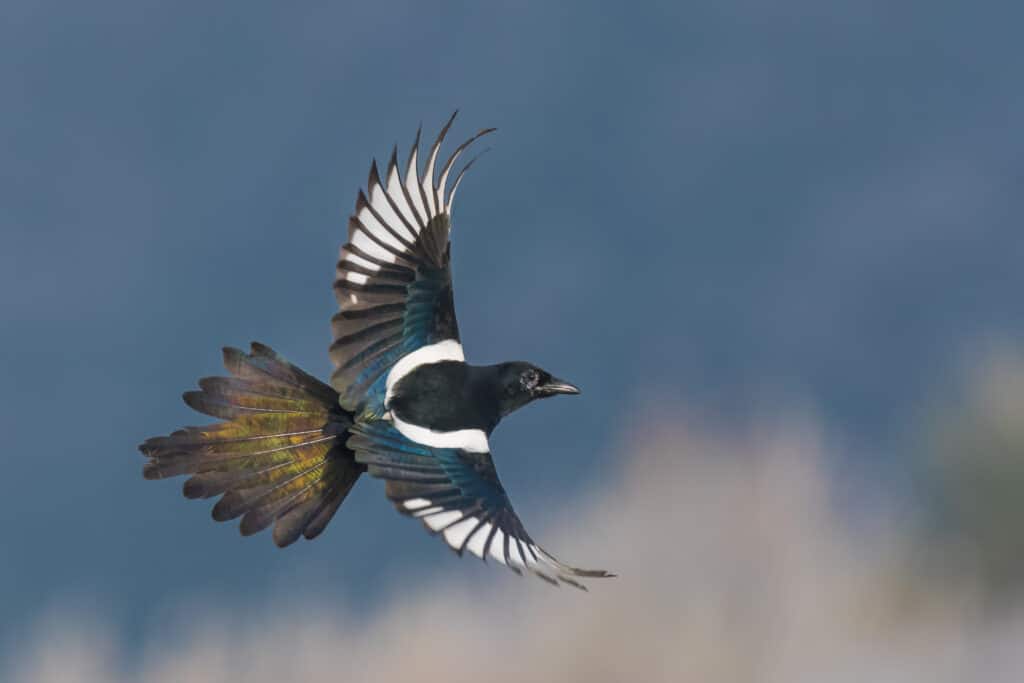
©Rafal Szozda/Shutterstock.com
The Eurasian magpie (Pica pica) is a bird species that belongs to the crow family. These birds are known for their distinct black and white plumage and long tails, with an average length of 17-20 inches. They are found throughout Europe, Asia, and North Africa, in various habitats such as woodlands, gardens, parks, and even urban areas.
In 2008, a team of researchers conducted a mirror test experiment on magpies to determine if they possess self-awareness. During this study, eight Eurasian magpies were placed one at a time inside individual cages equipped with mirrors The cages were vertically next to each other, and this allowed them to see themselves from different angles when looking into any one of those mirrors. Additionally, they had no prior experience with mirrors which made this study all more interesting.
The results showed that these birds not only passed but excelled at the task given. They used their beaks or feet to touch or wipe off marks placed on their neck feathers while observing themselves in the reflection; they did this within minutes after being confronted with their image for the first time ever.
Bluestreak Cleaner Wrasse

Bluestreak cleaner wrasse surprisingly pass the mirror test.
©Vojce/Shutterstock.com
A Bluestreak cleaner wrasse (Labroides dimidiatus) is a species of fish commonly found in coral reefs. These small, brightly colored fish are known for their unique behavior of cleaning other fish’s bodies of other fish by eating parasites and dead skin cells off their scales.
In 2019, a study of several species of fish, including the Bluestreak cleaner wrasse, tested if they were capable of passing the mirror test.
When the Bluestreak Cleaner Wrasse went through the mirror test, which involves injecting a harmless brown gel to resemble a parasite, it showed signs of passing the test. The fish also responded to the modified mark test, wherein a colored tag was used. In response, the fish tried to scrape the tag off with its body. Gordon Gallup hypothesized the wrasse’s response may have been its natural instinct to detect parasites on other fish rather than recognize itself in the mirror.
The authors of the study have concluded that the Bluestreak cleaner wrasse exhibited self-awareness because it observed itself in the mirror before and after the scraping. The fish spent time investigating the mirror without any prior training, and it only scraped the area with a colored mark when it was in front of the mirror. It didn’t display this behavior when there was a transparent mark or when not in front of the mirror.
In 2022, researchers conducted further research on the mirror test with a larger group of wrasses and various marking methods. Their findings suggested that cleaner fish might be capable of passing the mark test, as the wrasses seemed to try to remove the mark if it resembled a parasite. This gave the researchers more confidence in their results.
Manta Ray
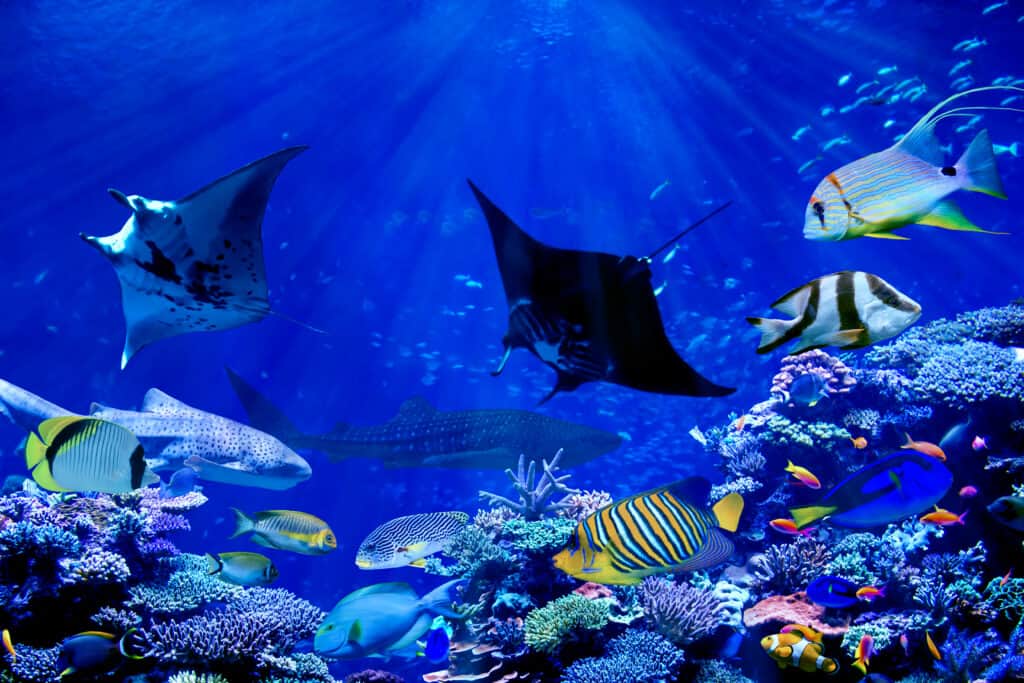
A pair of manta rays took the mirror test in 2016, and both passed, shocking researchers.
©chonlasub woravichan/Shutterstock.com
Manta rays, scientifically known as Mobula birostris, are large, gentle creatures belonging to the cartilaginous fish family. They have flattened bodies and wide pectoral fins that resemble wings, which they use to glide effortlessly through ocean waters. These graceful giants can grow up to 23 feet in length and weigh over two tons.
In 2016, a groundbreaking study was conducted on two captive manta rays at the Atlantis Resort in Dubai. The experiment involved performing the mirror test on these magnificent animals to determine their self-awareness. The results were astounding – both manta rays passed the mirror test with flying colors! This discovery suggests these intelligent creatures may have more complex cognition than previously believed. Manta rays may possess some level of self-awareness similar to other highly intelligent animals such as dolphins and primates.
This research highlights how important it is for humans to understand and respect all living beings around us, no matter how different they may be from us. Recognizing that even manta rays have emotions and intelligence worthy of consideration when we interact with them or impact their lives directly or indirectly through our actions towards oceans’ health will help preserve them for future generations.
The photo featured at the top of this post is © qingqing/Shutterstock.com
Thank you for reading! Have some feedback for us? Contact the AZ Animals editorial team.






